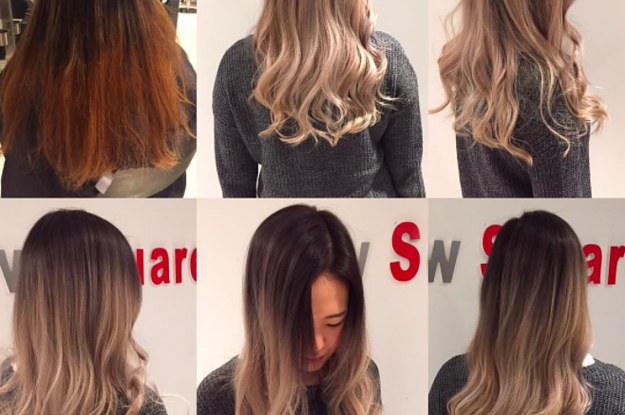Table Of Content

Apply bleach to a few hidden strands from the underneath layer of your hair and time how long it takes to lighten. Bleaching your hair should be done in sections so you should comb your hair beforehand. If you are planning to apply the bleach on your hair while it is damp or wet, be careful while brushing or combing it.
Is It a Good Idea to Use Purple Shampoo on Dry Hair? - Good Housekeeping
Is It a Good Idea to Use Purple Shampoo on Dry Hair?.
Posted: Fri, 24 Jul 2020 07:00:00 GMT [source]
For A Subtle Color Change
More than 50% of women[1] decide to change the color of their hair. As a method of lightening hair, bleaching decomposes chemicals that give hair its natural color. Having lighter hair ends is among the popular trends for this year. You can bleach or dye hair while it is still wet as it adds a subtle definition for your sun-kissed and gorgeous hair. You can ask your hair colorist to add more bleach to wet hair ends to enhance the effect. If you want a straightforward answer, then no it’s not recommended to dye wet hair.
What Occurs When Bleach Is Applied to Wet Hair?
And when it comes to using bleach, one of the most popular questions centers around how long bleach should be left in the hair. Below, we’re sharing the answer to that question as well as what happens if you exceed the recommended time. Although wet hair results in a faster hair-lightening reaction, the color change isn’t as drastic as when you apply it to dry hair. Sometimes, this technique is used for highlights if the hair colorist only aims to lighten the bleached hair a few shades lighter than the rest. This could help the lightened hair strands stand out but still blend well with the rest of the hair.
Factor #2: Your Starting Color
However, it’s essential to consider the specific bleach and developer you’re using and follow the manufacturer’s guidelines. If uncertain, seeking advice from a professional colorist is recommended to avoid hair damage and achieve the desired result. Bleaching wet hair, commonly known as wet balayage, results in a delicate shift in hair color.
What are the safest bleaching products for home use?
The cuticle scales are already raised when your hair is wet. The cortex is easily penetrated by the bleach, and it can then degrade melanin there. So, if we apply bleach on our locks while they are still damp, it will make the bleaching effect less powerful. First of all, it is important to figure out what happens to our chevelure when we expose it to the bleaching agent. Without a proper understanding of the procedure, we won’t be able to tell exactly how wet hair reacts to bleach.
Skincare Mistakes to Avoid for Healthy, Clear Skin
Lighter or brighter hair ends are a major hair trend this year. This futuristic look is achieved by bleaching damp hair ends. Before you even consider bleaching your damp hair, it’s important to take a few preparatory steps. Coat your hair with moisture protection like L’Oréal Paris Feria Hyper Platinum Advanced Lightening System Bleach beforehand.
Can You Bleach Wet Hair, and Other Coloring Tips

When you apply bleach to dry hair, the bleach penetrates the cuticle. This reduces the pigment in your hair, resulting in a lighter color. Plus, at-home coloring kits include directions that you should always follow. They likely won’t involve applying bleach or dye to wet hair. To maintain your bleached hair’s health and vibrancy, use deep conditioning treatments, limit heat styling, and use color-safe products. It is best to avoid washing your hair just before bleaching, as it strips away natural oils that protect your scalp, making it more likely to experience irritation.
They know how to use the technique safely while preventing your natural locks from damage. For instance, a hair colorist will apply the right conditioner after bleaching your mane to minimize dried and damaged hair. To sum up, it is best to work with a colorist to get the look you dream.
Lightening Hair Faster With Wet Bleaching
If not, book an appointment at a hair salon and get bleaching done on wet hair from a professional. This would also help you understand the process better and get pro hair tips from the stylist. In fact, we have discussed a guide about how to bleach wet manes on your own. However, if you are not an expert or don’t have the required confidence, it’s better that you leave the job to a professional colorist rather than doing it yourself. • When you bleach on wet hair, the tresses are likely to suffer from minimal damage.
By doing so, you're providing your hair with the best possible defense against the taxing effects of bleach. Hair porosity plays a significant role in how bleach interacts with your hair. They understand how to assess hair type, texture, and condition, and can customize the treatment for your specific needs.

While it’s no secret, bleach can damage damp hair, there are a few reasons why this trend works and when it’s okay to use it on your strands. Keep reading to learn more about when you can and can’t bleach wet hair. Many experts recommend getting hair bleached by a professional.
The synthetic unit will most likely get ruined since the artificial hair is badly penetrated with the bleaching agent. That is why we must be very careful when doing it at home without professional help. Dirty hair is more oily and greasy, and that’s the recommended state of hair if someone wants to bleach their hair. For rinsing, use plenty of water first to remove your product. Always deep condition your hair before bleaching to bring it to its best form.
For bleaching wet hair, balayage and ombre techniques are often used to create unique color effects. By incorporating these products into your hair care routine, you can protect your bleached hair and enjoy a stunning, long-lasting color. Minimizing the use of heat styling tools on bleached hair is essential for preventing further damage and maintaining hair health. By seeking the help of a professional, you can ensure your wet hair bleach is applied correctly and achieves the desired level of lightness without causing unnecessary damage. By following these precautions, you can safely achieve the balayage look with wet hair and enjoy a gorgeous, natural-looking hair color transformation. By applying a lightening product to the hair without using foil, the balayage technique achieves a sun-kissed, natural look with minimal contrast between colors.
What Causes Hair Damage? The 12 Worst Things You Can Do - Who What Wear
What Causes Hair Damage? The 12 Worst Things You Can Do.
Posted: Wed, 24 Feb 2021 08:00:00 GMT [source]
Achieving an even color lift requires careful application, as bleach can spread differently on wet hair. Bleaching wet hair can be less harsh, as the water dilutes the bleach solution—it may help to achieve a more even application with reduced risk of developing patchy areas. Utilizing the right products before and after bleaching is crucial for maintaining hair health. It’s recommended to precisely follow the application guidelines to ensure a safe bleaching experience. The oxidation process caused by bleach can weaken hair strands if not done correctly, leading to dryness and breakage. Prolonged exposure to the sun's UV rays can fade your hair color.
However, that also means that the hair is not completely stripped of its natural pigment. Hence, if you want to go bold but not too loud and keep your hair protected, bleaching wet hair is a great option. Here’s a rundown of why bleaching wet hair is a better option. Deep-conditioning your hair before bleaching can enhance its resilience.
If you’ve got an unwanted color before, you can bleach wet hair to correct that shade. So if you’re looking for thicker hair after you’re done with the bleaching session, opt for wet bleaching. Incorporate Fully Vital’s hair care products that aim to restore hydration and elasticity, helping rejuvenate and protect your hair post-bleach. Ensuring the correct ratio of bleach to developer can prevent unnecessary hair damage and yield a consistent result. Dry hair bleaching often requires more product and precision but can yield dramatic and longer-lasting results. It's important to apply the bleach evenly and watch closely to avoid over-processing, which can result in damage.

No comments:
Post a Comment